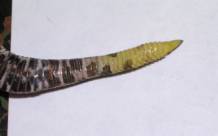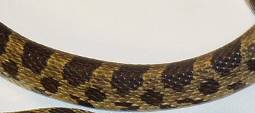Does it have a rattle at the end of its tail? Many snakes, including the fox snake, can make a rattling sound, but only rattlesnakes have a very obvious structure (Fig. 1) made of a horny material similar to fingernail at the end of the tail. In very young Massasaugas, the rattle is a simple structure, yellow in color (Fig. 2). Segments (or rattles) are added each time the snake sheds its skin. An adult snake may have seven or more rattle segments (Fig. 3), although terminal segments can be lost as a result of injury or irregular shedding. The Fox Snake lacks a rattle. Its tail ends in a sharp point (Fig. 4), unless damaged. Fox snakes and many other non-venomous snakes will shake their tails when threatened. If the tail happens to be close to dry leaves or a cardboard box, for example, it can make a sound similar to that of a rattlesnake.




Where (geographic location) did you see the snake? Massasaugas are currently known only from 4 or 5 places in Illinois: Cook County, Knox County, Piatt County, and Clinton County. In addition, Massasaugas are limited to one or two small locations in each of those counties, so the chances of being in one of those exact spots are low. There is the possibility, although remote, that new populations will be discovered in Illinois, so all sightings are worth reporting. I am always happy to identify images of snakes (and any other reptile or amphibian). Send digital images to me at chrisp@inhs.illinois.edu. Include the geographic location and any details of the surrounding habitat (e.g., grassy field near a wetland).
Other information and images that may help distinguish between the two species.While both species share an overall similar pattern on the back (dark blotches on a lighter background), the blotches of a Massasauga are best described as bow ties (thinner in the middle than at either side) with a very thin lighter margin (Fig. 5), while those of a Fox Snake are more rectangular or square and have no contrasting margin (adults, Fig. 6) or a darker contrasting margin (juveniles).


Finally, the heads of the two species are quite different, but getting close enough to see these details is not recommended. The head of the Fox Snake is often a slightly different color than the body, especially in adults (Fig. 7), while the head of a Massasauga is similar to that of the body (Fig. 8). In addition, the pupils of the Massasauga are vertical as opposed to horizontal in the Fox Snake.



